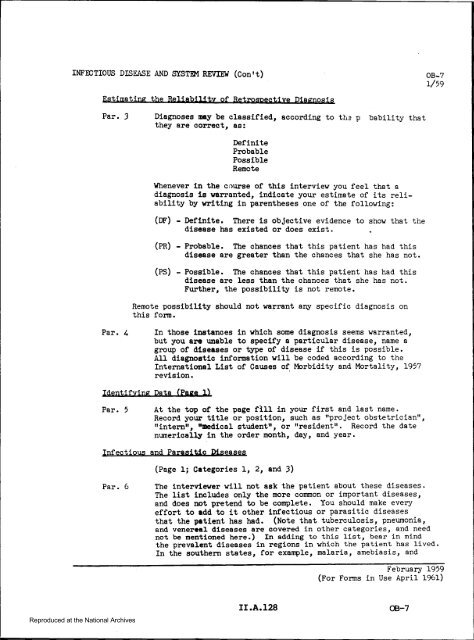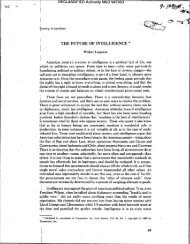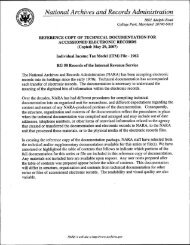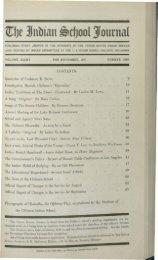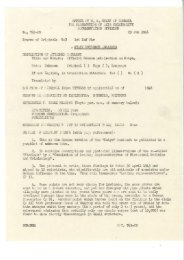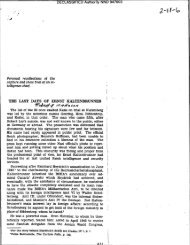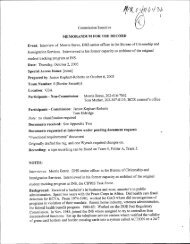- Page 1 and 2:
NINCDS COLLABORATIVE PERINATAL PROJ
- Page 3 and 4:
NINCDS COLLABORATIVE PERINATAL PROJ
- Page 5 and 6:
INTRODUCTION DOCUMENT OBJECTIVES AN
- Page 7 and 8:
Forms The first forms used in the s
- Page 9 and 10:
Reproduced at the National Archives
- Page 11 and 12:
selection. A n1n was used for patie
- Page 13 and 14:
, researcher is more likely to look
- Page 15 and 16:
TABLE 3. Abbreviations for Person,
- Page 17 and 18:
TABLE 4. Definition of Person, Time
- Page 19 and 20:
TABLE 4. Definition of Person, Time
- Page 21 and 22:
CONTENTS AR-1/0B-1 OB-2 OB-3 OB
- Page 23 and 24:
AR-1 Obstetrical Administrative Rec
- Page 25 and 26:
Reproduced at the National Archives
- Page 27 and 28:
Reproduced at the National Archives
- Page 29 and 30:
DEFINITION OF CODES {Continued) FOR
- Page 31 and 32:
... 1;:: I ~ .J.I'40JI.!9d jl5 !
- Page 33 and 34:
ADMINISTRATIVE RECORD MANUAL PHS-30
- Page 35 and 36:
ADMI!liSTRATIVE RECORD ;fl.A.TI.TUA
- Page 37 and 38:
-· IID'~7-- '·"'-- ':!e- ~ l·-~
- Page 39 and 40:
OB-1: OBSTETRICAL· ADMINISTRATIVE
- Page 41 and 42:
Par. 3 10 - Religion. Record as Cat
- Page 43 and 44:
OB-2 Reproductive History Form OB-2
- Page 45 and 46:
Reproduced at the National Archives
- Page 47 and 48:
COLIII:•IOoa-& ,.., REPRODUCTIVE
- Page 49 and 50:
Reproduced at the National Archives
- Page 51 and 52:
DEFTIITTION OF CODES (Continued) FI
- Page 53 and 54:
1 Reproduced at the National Archiv
- Page 55 and 56:
R~PRODUCTI\~ HISTORY (Con't.) C3-2
- Page 57 and 58:
REPRODUCTIVE HISTORY (Con•t.) C3-
- Page 59 and 60:
OB-3 History Since Last Menstrual P
- Page 61 and 62:
Reproduced at the National Archives
- Page 63 and 64:
eoL"-aooa.a ACV. n-et • HISTORY S
- Page 65 and 66:
Reproduced at the National Archives
- Page 67 and 68:
DEFINITION OF CODES (Continued) FOR
- Page 69 and 70:
DEFJNITION OF CODES (Continued) FOR
- Page 71 and 72:
"' 1: : ~~ :; "':J. !~ ~ ~ :~ ~ ; :
- Page 73 and 74:
HISTORY SINCE LAST 1-ENSTRUAL PERIO
- Page 75 and 76:
HISTORY SINCE ~T MENSTRQ~ P~RIOD {C
- Page 77 and 78:
OB-4 Gynecological History Form OB-
- Page 79 and 80:
Reproduced at the National Archives
- Page 81 and 82:
COL.,.-aaaa-4 RIEV. tt-11 • GYNEC
- Page 83 and 84:
DEFINITION OF CODES GYNECOLOGICAL H
- Page 85 and 86:
DEFINITION OF CODES (Continued) FIE
- Page 87 and 88:
'? I~ 1: :1\ j; t:: t; ....J 7 ,.
- Page 89 and 90:
GY1~F..COLOGICAL HISTORY (Con't.) O
- Page 91 and 92:
08-5 Recent Medical History Form 08
- Page 93 and 94:
Reproduced at the National Archives
- Page 95 and 96:
Reproduced at the National Archives
- Page 97 and 98:
Reproduced at the National Archives
- Page 99 and 100: DEFINITION OF CODES RECENT MEDICAL
- Page 101 and 102: DEl!'INITION OF CODES (Continued) F
- Page 103 and 104: DEFINITION OF CODES (Continued) FOR
- Page 105 and 106: DEFINITION OF CODES (Continued) FOR
- Page 107 and 108: ILL..'1ESS OR DISABILITY CODES (Con
- Page 109 and 110: Reproduced at the National Archives
- Page 111 and 112: RECENT MEDICAL HISTORY (Con 1 t) OB
- Page 113 and 114: OB-6 Past Medical History Form OB-6
- Page 115 and 116: Reproduced at the National Archives
- Page 117 and 118: z PAST MEDICAL HISTORY (Interviewer
- Page 119 and 120: Reproduced at the National Archives
- Page 121 and 122: DEF'll'UTION OF CODES PAST MEDICAL
- Page 123 and 124: DEF'INli'ION OF CODES (Continued) F
- Page 125 and 126: DEFINITION OF CODES (Continued) u.
- Page 127 and 128: DEFINITION OF CODES (Continued) FOO
- Page 129 and 130: Reproduced at the National Archives
- Page 131 and 132: PAST HEDICAL HISTORY (Con't) Item 1
- Page 133 and 134: HISTORY TAKEN BY PAST MEDICAL HISTO
- Page 135 and 136: OB-7 Infectious Disease and System
- Page 137 and 138: Reproduced at the National Archives
- Page 139 and 140: COLIII.•I00 ..7 ,... INFECTIOUS D
- Page 141 and 142: C:OLft-IOOa-7 1··· INFECTIOUS DI
- Page 143 and 144: DEFINITION OF CODES nlFECTIOO'S DIS
- Page 145 and 146: DEl''ll'IITION OF C:JDES ( Conti:::
- Page 147 and 148: i i :a :: ·• 1: !: ! I! ::
- Page 149: l!:i i!;T!IJIJ;: IIJ;;:..f,;:l·: .
- Page 153 and 154: OB-8 Repeat Prenatal History Form O
- Page 155 and 156: Reproduced at the National Archives
- Page 157 and 158: I. ftATIIMT IDfNTIPICATIOM REPEAT P
- Page 159 and 160: Reproduced at the National Archives
- Page 161 and 162: DEFINITION OF CODES (Continued) FOR
- Page 163 and 164: DEFINITION OF CODES (Continued) FIE
- Page 165 and 166: ~ :: : j: ~ : I~ =r ; Ia ~ ~ !~ ;
- Page 167 and 168: ,;.-~ 1•1. 1J;,.... - ~ .. u;W'o'
- Page 169 and 170: OB-9 Prenatal Record Form OB-9, Pre
- Page 171 and 172: Reproduced at the National Archives
- Page 173 and 174: Reproduced at the National Archives
- Page 175 and 176: Reproduced at the National Archives
- Page 177 and 178: C:OL.II.·- I•It NU\E IHOSPITAL
- Page 179 and 180: •• 'HISTORY NO. diRIRXL IXXMI l
- Page 181 and 182: Reproduced at the National Archives
- Page 183 and 184: Reproduced at the National Archives
- Page 185 and 186: ~~J2ITTIGN OF CODES (Co~~i~ued) FCa
- Page 187 and 188: DEFINITION OF CODES (Continued) FOF
- Page 189 and 190: DEF~~ION OF CODES (Continued) PELVI
- Page 191 and 192: DEFTIHTION OF CODES (Continued) FQR
- Page 193 and 194: DEFINITION OF CODES (Continued) FIE
- Page 195 and 196: ZEFT1ITTIO:i OF CODES (Con"'c:..!!U
- Page 197 and 198: DEFINITION OF CODES (Continued) FOR
- Page 199 and 200: DEFINITION OF CODES (Continued) FIE
- Page 201 and 202:
DEFINITION OF CODES ( Con~inued) FC
- Page 203 and 204:
DEFINITION OF CODES (Continued) FOR
- Page 205 and 206:
:t , I~ I ~ It II! I~ ::: .. ~ .. ~
- Page 207 and 208:
!:: llil\41.0 ~ ~~ ~'~"'~ -N OB-9 -
- Page 209 and 210:
PRENATAL RECORD (Con 1 t) PRESENT P
- Page 211 and 212:
PRENATAL RECORD (Con 't) complete a
- Page 213 and 214:
PRENATAL RECORD (Can't) EVALUATION
- Page 215 and 216:
PRENATAL RECORD (Con't) GENERAL IDl
- Page 217 and 218:
OB-42 Past Medical History Form OB-
- Page 219 and 220:
Reproduced at the National Archives
- Page 221 and 222:
-· eoL"-aooa-..a 08-42 PAST MEDICA
- Page 223 and 224:
Reproduced at the National Archives
- Page 225 and 226:
DEFINITION OF CODES (Continued) FIE
- Page 227 and 228:
DEFINITION OF CODES (Continued) FOR
- Page 229 and 230:
Instruction Manual for Obstetric Fo
- Page 231 and 232:
OB-43 Initial Prenatal Examination
- Page 233 and 234:
Reproduced at the National Archives
- Page 235 and 236:
Reproduced at the National Archives
- Page 237 and 238:
COL ..-3008-41 UIIYe 10.U) 1. PATIE
- Page 239 and 240:
Reproduced at the National Archives
- Page 241 and 242:
DEFINITION OF CODES miTIAL PRENATAL
- Page 243 and 244:
DEFINITION OF CODES (Continued) FOR
- Page 245 and 246:
DEFINITION OF CODES (Continued) FIE
- Page 247 and 248:
DEFINITION OF CODES (Continued) FOB
- Page 249 and 250:
DEF'INITION OF CODES (Continued) FO
- Page 251 and 252:
I ,rnrn:r s YIN.Ct:l S6¥:;~rn I
- Page 253 and 254:
Instruction Manual for Obstetric Fo
- Page 255 and 256:
Instruction Manual for Obstetric Fo
- Page 257 and 258:
I, I'ATIENT IDENTI,.ICATIDN OB-43 I
- Page 259 and 260:
OB-10 Return Visit and Laboratory R
- Page 261 and 262:
Reproduced at the National Archives
- Page 263 and 264:
Reproduced at the National Archives
- Page 265 and 266:
Reproduced at the National Archives
- Page 267 and 268:
Reproduced at the National Archives
- Page 269 and 270:
DEFINITION OF CODES (Continued) FIE
- Page 271 and 272:
DEFTIUTION OF CODES (Continued) FOR
- Page 273 and 274:
DEFINITION OF CODES (Continued) FOB
- Page 275 and 276:
Reproduced at the National Archives
- Page 277 and 278:
4/16/61 OB-10 RETURN VISIT AND LAB
- Page 279 and 280:
~"........ ,... ~,_~.a., RETURN VIS
- Page 281 and 282:
OB-44 Prenatal Observations Form OB
- Page 283 and 284:
Reproduced at the National Archives
- Page 285 and 286:
..... C:Ol..llt-IOOa-44 1. PATIENT
- Page 287 and 288:
Reproduced at the National Archives
- Page 289 and 290:
:FDRMS 03-10 DEFINITION OF CODES (C
- Page 291 and 292:
DEFINITION OF CODES (Continued) ~·
- Page 293 and 294:
DEFINITION OF CODES (Continued) FIE
- Page 295 and 296:
Instructional Manual for Obstetric
- Page 297 and 298:
OB-45 Laboratory Record Form OB-45
- Page 299 and 300:
Reproduced at the National Archives
- Page 301 and 302:
Reproduced at the National Archives
- Page 303 and 304:
Reproduced at the National Archives
- Page 305 and 306:
Reproduced at the National Archives
- Page 307 and 308:
Reproduced at the National Archives
- Page 309 and 310:
Reproduced at the National Archives
- Page 311 and 312:
Reproduced at the National Archives
- Page 313 and 314:
DEFllUTION OF CODES LABJRATORY RECO
- Page 315 and 316:
DEFJNITION OF CODES (continued) FIE
- Page 317 and 318:
DEFINITION OF CODES (continued) FOR
- Page 319 and 320:
DEFINITIDN OF CODES (continued) FOR
- Page 321 and 322:
DEFTIUTION OF CODES (continued) FOR
- Page 323 and 324:
DEFINITION OF CODES (continued) FIE
- Page 325 and 326:
DEFINITION OF CODES (continuted) FI
- Page 327 and 328:
DEFTIHTION OF CODES (continued) FIE
- Page 329 and 330:
DEFTIUTION OF CODES (continued) FIE
- Page 331 and 332:
Reproduced at the National Archives
- Page 333 and 334:
Reproduced at the National Archives
- Page 335 and 336:
Reproduced at the National Archives
- Page 337 and 338:
Reproduced at the National Archives
- Page 339 and 340:
Instruction Manual for Obstetric Fo
- Page 341 and 342:
OB-11 Record of Current Pregnancy F
- Page 343 and 344:
CO~A·3C03·11 lltEV. '7·58 I. PAT
- Page 345 and 346:
RECORD OF CURRENT PREGNANCY (For Fo
- Page 347 and 348:
,... RECORD OF CURRENT PREGNANCY IN
- Page 349 and 350:
OB-46 Physician•s Clinic Record,
- Page 351 and 352:
COLR-1001-4e 4-a I. PATIENT IDENTII
- Page 353 and 354:
Instruction :\l:J.nual for Obstetri
- Page 355 and 356:
OB-12 Summary of Hospitalization fo
- Page 357 and 358:
SUMMARY OF HOSPITALIZATION FOR ANY
- Page 359 and 360:
SUMMARY OF HOSPITALIZATION FOR ANY
- Page 361 and 362:
':.::-•••suMMARY OF HOSPITALI
- Page 363 and 364:
OB-47 Summary of Antepartum Hospita
- Page 365 and 366:
· COLIII-IOOa..7 (CHANGIED 2-8a)
- Page 367 and 368:
Instruction Manual for Obstetric Fo
- Page 369 and 370:
OB-15 Drugs in Pregnancy Form OB-15
- Page 371 and 372:
Reproduced at the National Archives
- Page 373 and 374:
PH S.300S.18 ..... PATIENT IDENTIFI
- Page 375 and 376:
.... PMS•3003•18 PATIENT IDENTI
- Page 377 and 378:
PHI·IOOI .. 1B P"TIENT IOENTIFIC"T
- Page 379 and 380:
PATI~NT IDENTIFICATION OB-15 DRUGS
- Page 381 and 382:
..... PHS .. 3003 ... 11 PATII!NT I
- Page 383 and 384:
Reproduced at the National Archives
- Page 385 and 386:
DEFINITION OF CODES DRUGS lN PREGN
- Page 387 and 388:
Drugs in Pregnancy (08-15) Blank 0
- Page 389 and 390:
Drugs in Pregnancy (cont.} 2128 Par
- Page 391 and 392:
Orugs in Pregnancy (cont.) 4256 Hyo
- Page 393 and 394:
. Drugs in Pregnancy (cont.) 7154 S
- Page 395 and 396:
1 Drugs in Pregnancy (cont.) 7482 O
- Page 397 and 398:
Drugs in Pregnancy (cont.) 9169 917
- Page 399 and 400:
Drugs in Pregnancy (cont.) 9949 995


